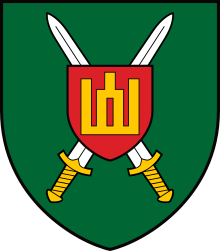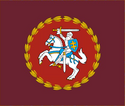Lithuanian Land Forces
| Lithuanian Land Force | |
|---|---|
| Lietuvos sausumos pajėgos | |
 Insignia of Land Forces Command | |
| Active | 1918–1940, 1990–present |
| Country | |
| Branch | Army |
| Type | Land force |
| Role | Defend territory of Lithuania and act as an integral part of NATO forces |
| Size | 12,000 active duty 5,400 volunteer force ~3,500 conscripts[1] |
| Part of | Lithuanian Armed Forces |
| Garrison/HQ | Vilnius |
| Motto(s) | Vienybėje jėga, tikėjime - pergalė! (Translation: "Strength in unity, victory in trust!") |
| Equipment | Lithuanian army equipment |
| Website | Official site |
| Commanders | |
| Current commander | Brigadier general Artūras Radvilas |
| Chief of Staff | Colonel Viktoras Bagdonas |
| Insignia | |
| Flag of Lithuanian Land Force |  |
| Flag of Land Forces Command |  |
 |
| Lithuanian Armed Forces |
|---|
| Components |
| Administration |
| Personnel |
| Equipment |
| History |
| Lithuania portal |
The Lithuanian Land Forces (LLF) form the backbone of the Lithuanian Armed Forces, capable of acting as an integral part of NATO forces. Lithuanian Land Forces consist of three brigades, the Engineer Battalion, and the National Defence Volunteers Division.
Structure
[edit]The main element of the Land Forces is a single mechanised infantry brigade, the Iron Wolf Mechanised Infantry Brigade. This is formed around three mechanized infantry battalions and an artillery battalion, all named after Lithuanian grand dukes as the tradition of the Lithuanian Armed Forces goes.
In addition to the formed infantry brigade, the Land Forces maintain a second brigade composed of three motorised infantry battalions and one artillery battalion; one of these is tasked to support operations both domestically and overseas; one is tasked primarily with the defence of territorial Lithuania. There is a third brigade, which is a mobilization brigade but in peace time is a training unit.
Juozas Vitkus Engineer Battalion is responsible for mine clearance, the construction of pontoon bridges, unexploded ordnance detonation tasks, underwater engineering, and participation in search and rescue operations. The Explosive Ordnance Disposal Platoon is ready to participate in international operations. Starting in 2008, the Lithuanian Armed Forces launched a 10-year-long project continuing mine cleaning on Lithuanian territory of explosives left after the First and Second World War, and in former Soviet military bases.
As an integral part of the Land Forces, the National Defence Volunteers have been developing since the beginning of the national movement for independence. The volunteers act smoothly together with the Allies during military operations and have been assigned new missions: to augment the regular forces, to deploy individual units and specific capabilities for international operations, to assist host nation support and to support the civilian authorities.
Organization 2023
[edit]
With the reintroduction of conscription in 2015 the Lithuanian Land Force began an expansion of its main combat formations. As of May 2023 the land forces consist of the following units:
 Lithuanian Land Forces Headquarters, in Vilnius
Lithuanian Land Forces Headquarters, in Vilnius
 Iron Wolf Infantry Brigade
Iron Wolf Infantry Brigade Žemaitija Infantry Brigade
Žemaitija Infantry Brigade Aukštaitija Infantry Brigade
Aukštaitija Infantry Brigade National Defence Volunteer Forces
National Defence Volunteer Forces Colonel Juozas Vitkaus Engineer Battalion, in Kaunas
Colonel Juozas Vitkaus Engineer Battalion, in Kaunas Juozas Lukša Training Center
Juozas Lukša Training Center
Iron Wolf Infantry Brigade
[edit] Infantry Brigade "Iron Wolf", in Rukla:[2]
Infantry Brigade "Iron Wolf", in Rukla:[2]
- Headquarters and Headquarters Company, in Rukla
 King Mindaugas Hussar Battalion, in Panevėžys (M113A2 armored personnel carriers)
King Mindaugas Hussar Battalion, in Panevėžys (M113A2 armored personnel carriers) Grand Duchess Birutė Uhlan Battalion, in Alytus (Vilkas infantry fighting vehicles)
Grand Duchess Birutė Uhlan Battalion, in Alytus (Vilkas infantry fighting vehicles) Grand Duke Algirdas Infantry Battalion, in Rukla (Vilkas infantry fighting vehicles)
Grand Duke Algirdas Infantry Battalion, in Rukla (Vilkas infantry fighting vehicles) Duke Vaidotas Infantry Battalion, in Rokantiškės (M113A2 armored personnel carriers)
Duke Vaidotas Infantry Battalion, in Rokantiškės (M113A2 armored personnel carriers) General Romualdas Giedraitis Artillery Battalion, in Rukla (Panzerhaubitze 2000 self-propelled howitzers)
General Romualdas Giedraitis Artillery Battalion, in Rukla (Panzerhaubitze 2000 self-propelled howitzers)- NATO Enhanced Forward Presence Battle Group, in Rukla
- Logistics battalion, in Rukla
- Reconnaissance Company, in Rukla
- Signal Company, in Rukla
Griffin Infantry Brigade
[edit]The Žemaitija (Griffin) Infantry Brigade was activated on 1 January 2016.[3]
 Žemaitija Infantry Brigade, in Klaipėda:[4]
Žemaitija Infantry Brigade, in Klaipėda:[4]
- Headquarters and Headquarters Company, in Klaipėda
 Grand Duke Butigeidis Dragoon Battalion, in Klaipėda (M113A2 armored personnel carriers)
Grand Duke Butigeidis Dragoon Battalion, in Klaipėda (M113A2 armored personnel carriers) Grand Duke Kęstutis Infantry Battalion, in Tauragė (M113A2 armored personnel carriers)
Grand Duke Kęstutis Infantry Battalion, in Tauragė (M113A2 armored personnel carriers) Prince Margiris Infantry Battalion, in Šiauliai (M113A2 armored personnel carriers)
Prince Margiris Infantry Battalion, in Šiauliai (M113A2 armored personnel carriers) Brigadier General Motiejus Pečiulionis Artillery Battalion, in Pajūris (M101 towed howitzers, will be replaced by self-propelled Caesar NG howitzers)
Brigadier General Motiejus Pečiulionis Artillery Battalion, in Pajūris (M101 towed howitzers, will be replaced by self-propelled Caesar NG howitzers)- Logistics Battalion
- Reconnaissance Company
- Signal Company, in Klaipėda
Aukštaitija Infantry Brigade
[edit]The Aukštaitija Infantry Brigade is a reserve brigade, which was activated on 23 March 2017. In peacetime the brigade's headquarter staff works at the Lithuanian Armed Forces Training and Doctrine Command. The brigade's three maneuver battalions are made up of reservists, while the three battalion's headquarters personnel works in peacetime at the Division General Stasys Raštikis Lithuanian Armed Forces School, Great Lithuanian Hetman Jonušas Radvila Training Regiment, and General Adolfas Ramanauskas Combat Training Center. The brigade's reconnaissance company is composed of conscripts, while the brigade's headquarters, signal and logistic units are composed of professional soldiers. When activated the brigade consists of around 4,500 troops.
 Aukštaitija Infantry Brigade, in Vilnius:[5]
Aukštaitija Infantry Brigade, in Vilnius:[5]
- Headquarters and Headquarters Company
- Infantry (Reserve) Battalion
- Infantry (Reserve) Battalion
- Infantry (Reserve) Battalion
- Artillery (Reserve) Battalion
- Logistics Battalion
- Reconnaissance Company
- Signal Company
National Defence Volunteer Forces
[edit] National Defence Volunteer Forces, in Vilnius[6]
National Defence Volunteer Forces, in Vilnius[6]
- 1st Territorial Unit Dainava District, in Alytus
- Headquarters & Supply Company, in Alytus
- 9× infantry companies, in Alytus, Varėna, Lazdijai, Vilkaviškis, Marijampolė, Druskininkai, and Kalvarija
- 2nd Territorial Unit Darius and Girėnas District, in Kaunas
- Headquarters & Supply Company, in Kaunas
- 9× infantry companies
- 3rd Territorial Unit Žemaičiai District, in Klaipėda
- 5th Territorial Unit Vytis District, in Panevėžys
- 6th Territorial Unit Prisikėlimo District, in Šiauliai
- Headquarters & Supply Company, in Šiauliai
- 9× infantry companies Šiauliai (2×), Mažeikiai, Telšiai, Kelmė, Joniškis, Pakruojis, Radviliškis, and Naujoji Akmenė
- 8th Territorial Unit Didžioji Kova District, in Vilnius
- Headquarters & Supply Company, in Vilnius
- 9× infantry companies Vilnius (2×), Nemenčinė, Trakai, Ukmergė, Molėtai, Ignalina, Švenčionys, and Šalčininkai
- Non-kinetic Operations Company, in Vilnius
- 1st Territorial Unit Dainava District, in Alytus
Equipment
[edit]
In reforming the Armed Forces, most of the available attention and financial resources have been directed to the development of the Land Forces. Lithuania has been modernizing its armed forces since 1990s and by now nearly all equipment is compatible with the NATO standards. The current efforts focus on increasing the firepower, acquiring new equipment and armaments, enhancing their operational effectiveness and combat training. The standard service assault rifle of the Lithuanian Armed Forces is the Heckler & Koch G36 and the standard pistol is the Glock 17. The Lithuanian Land Forces are also equipped with machine guns, including the GPMG MG-3, the FN MAG, and the 12.7mm (.50 cal.) M2 Browning machine gun. They also employ the AT-4 anti-tank rockets and Carl Gustav anti-tank recoilless rifles, HK GMG high-velocity grenade launchers, and low-velocity AG-36 under-the-barrel grenade launchers, in addition to light and heavy mortars. The army also uses high-technology Lithuanian-made tactical automated commanding and controlling informational systems (TAVVIS).
Reserves
[edit]
Lithuanian Land Forces are formed from professional military servicemen and volunteers. In 2008 the minister of national defence of Lithuania signed a law that ceased conscription in an effort to develop Lithuania's professional army. National defence is based on reserve forces and mobilisation forces. The new minister plans to increase national defence capabilities by making all males from 18 to 24 take 7 week military basic training. After that the person will be added to the military reserves.
The military conscription has been renewed in 2015 with a first draft of approx. 3000 draftees including volunteers, who will be assigned to military units starting from August 2015 and will complete a 9-month basic training. The updated law specifies that a draft of 3000 soldiers annually will continue at least until 2020, citing as the reason for renewed conscription the increased geopolitical risks in the region.[7]
Ranks
[edit]Commissioned officer ranks
[edit]The rank insignia of commissioned officers.
| NATO code | OF-10 | OF-9 | OF-8 | OF-7 | OF-6 | OF-5 | OF-4 | OF-3 | OF-2 | OF-1 | ||||||||||||||
|---|---|---|---|---|---|---|---|---|---|---|---|---|---|---|---|---|---|---|---|---|---|---|---|---|

|

|

|

|

|

|

|

|

|

| |||||||||||||||
| Generolas | Generolas leitenantas | Generolas majoras | Brigados generolas | Pulkininkas | Pulkininkas leitenantas | Majoras | Kapitonas | Vyresnysis leitenantas | Leitenantas | |||||||||||||||
Other ranks
[edit]The rank insignia of non-commissioned officers and enlisted personnel.
| NATO code | OR-9 | OR-8 | OR-7 | OR-6 | OR-5 | OR-4 | OR-3 | OR-2 | OR-1 | |||||||||||||||||||||||||||
|---|---|---|---|---|---|---|---|---|---|---|---|---|---|---|---|---|---|---|---|---|---|---|---|---|---|---|---|---|---|---|---|---|---|---|---|---|

|

|

|

|

|

|

|

|

| ||||||||||||||||||||||||||||
| Seržantas majoras | Viršila | Štabo seržantas | Vyresnysis seržantas | Seržantas | Grandinis | Vyresnysis eilinis | Eilinis | Jaunesnysis eilinis | ||||||||||||||||||||||||||||
Notes
[edit]- ^ "Personnel".
- ^ "Mechanized Infantry Brigade "Iron Wolf" » Units". Lithuanian Army. Retrieved 2 May 2020.
- ^ Media, Fresh. "Lietuvos kariuomenė :: Kariuomenės struktūra » Sausumos pajėgos » Padaliniai » Motorizuotoji pėstininkų brigada "Žemaitija"". kariuomene.kam.lt. Archived from the original on 29 January 2017. Retrieved 3 October 2017.
- ^ "Motorized Infantry Brigade "Samogitia" » Units". Lithuanian Army. Retrieved 2 May 2020.
- ^ Media, Fresh. "Ministry of National Defence Republic of Lithuania :: News » News Releases". kam.lt. Archived from the original on 24 March 2017. Retrieved 3 October 2017.
- ^ "Krašto apsaugos savanorių pajėgos". Lithuanian Armed Forces. Retrieved 9 May 2023.
- ^ "Lithuania's Defence Ministry releases military draft list". En.delft.lt. Retrieved 3 October 2017.
- ^ a b "Krašto apsaugos sistemos karių uniformų skiriamųjų ženklų etalonų ir jų dėvėjimo tvarkos aprašo 2 priedas" [Appendix 2 describes the standards of insignia of the national defense system soldiers' uniforms and the order of their wearing]. Office of the Seimas of the Republic of Lithuania (in Lithuanian). Retrieved 24 October 2024.
References
[edit]As of this edit, this article uses content from "Lithuanian Armed Forces :: Structure » Land Forces", which is licensed in a way that permits reuse under the Creative Commons Attribution-ShareAlike 3.0 Unported License, but not under the GFDL. All relevant terms must be followed.
- Lithuanian Ministry of Defence site
- Stefan Marx, 'Lithuania's Defence Structure,' Jane's Intelligence Review, September 1993, p. 407–409
Sources
[edit]- Hackett, James, ed. (2022-02-14). "The 2022 Military Balance Chart". The Military Balance. 122 (1). International Institute for Strategic Studies. ISSN 0459-7222.


